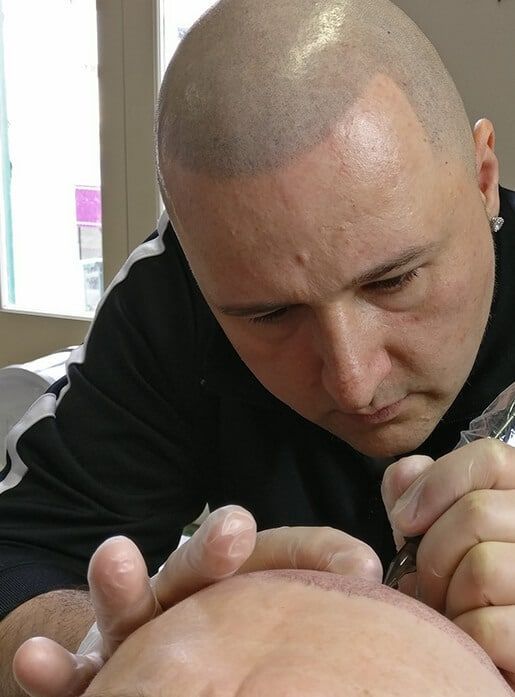SMP Training Program- Next class MAY 2024. WE NOW OFFER TATTOO LASER REMOVAL
Scalp Micropigmentation
Is it Possible to Have a Hair Transplant and Scalp Micropigmentation Treatment?
Is it Possible to Have a Hair Transplant and Scalp Micropigmentation Treatment?
With so many patients struggling from hair loss, the search for an effective hair loss solution is still ongoing. Thankfully, hair restoration has made great strides over the years and there are a number of treatment options that provide lasting, life-changing results. One of those treatments is scalp micropigmentation (SMP).
Scalp micropigmentation has risen in popularity as one of the most effective hair restoration methods out there thanks to its simplicity and effectiveness. It doesn’t require surgery and the results are permanent, making it an appealing option for people who want to address their hair loss concerns.
This has led many people questioning whether or not they should undergo hair transplant or scalp micropigmentation. Which treatment is better? Is it possible to have a hair transplant and scalp micropigmentation treatment? Today we’ll answer those questions by taking a closer look at the two procedures.
What is a hair transplant?
A hair transplant is a surgical procedure that addresses several hair loss problems, mainly alopecia. The procedure involves removing hair follicles from other parts of the body (donor area) and transfer them to the bald or thinning area. Latest methods of hair transplant deliver permanent results by picking up clusters of hair follicles in a process called Follicular Hair Transplantation (FUT).
FUT can be done in two ways, either by strip harvesting or by follicular unit extraction (FUE). Strip harvesting is the most common method of FUT due to its straightforward approach. A strip of hair is removed generally from the back of the head and is dissected into portions to plant the individual hair follicles. The only disadvantage is that strip harvesting leaves a linear scar which can look quite unsightly for patients who wear their hair short.
FUE on the other hand, works just like strip harvesting, although it’s a bit more time-consuming and tedious. The hair follicles are individually removed from the scalp skin and is then implanted by making small holes in your scalp. When done correctly, FUE gives very natural results with little to no marks.

What is scalp micropigmentation?
Scalp micropigmentation is a non-invasive, cosmetic tattoo procedure that aims to resemble natural hair follicles. Pigments are applied to the patient’s scalp to fill in bald spots or thinning areas to achieve a fuller, thicker head of hair. While scalp micropigmentation does not actually restore your hair, it does an excellent job of concealing thinning areas and bald spots in your scalp. SMP can also restore your receding hairline and edge your hair for a clean, youthful look.
Scalp micropigmentation is that it works with both fair and dark hair. You don’t have to worry about the treatment looking unnatural because the pigments are diluted to match your hair colour. If you’re looking for a hair loss treatment that conceals thinning hair, then scalp micropigmentation is the treatment for you.
How scalp micropigmentation works with fair hair
There’s a common misconception that scalp micropigmentation works only for clients with dark-coloured hair. This is because some people think it’s just a hair tattoo, thinking that the ink used for the treatment is only a black pigment. The good news is that clients with fair hair can undergo scalp micropigmentation and experience realistic results as well.
Clients with darker hair usually have denser hair follicles, meaning they look larger and darker upon close inspection. This is where scalp micropigmentation becomes favourable for darker-haired clients because they are able to go a shade darker with their treatment to achieve their desired look.
But that’s not to say that scalp micropigmentation doesn’t provide the same results for clients with fair hair. Actually, some of the most natural and indiscernible scalp micropigmentation results are from clients that have pale skin tones or fair hair. This is where the experience and expertise of your SMP artist will come in as they are responsible for blending the pigment perfectly to match your existing hair colour.
SMP artists can choose up to 60 different shades, ranging from black all the way up to white smoke. Usually, the artist will select a light shade during the initial session to ensure the treatment won’t look too dark after succeeding sessions. The patient can choose to have the pigment a shade darker depending on their preferences, but this will require them to wet shave regularly to avoid colour clash between their natural hair and their scalp micropigmentation treatment.
Bottom line
Both hair transplant and scalp micropigmentation have their own benefits. No treatment is better than the other and it all depends on your hair loss needs. For example, if you’re suffering from severe alopecia, then a hair transplant is the most obvious choice. But if you’re suffering from thinning hair and a receding hairline, then scalp micropigmentation can effectively address these problems.
It is possible to combine a hair transplant and scalp micropigmentation treatment. If you wish to conceal your hair transplant scars or if you want to add more density to your scalp after a hair transplant procedure, you should definitely consider scalp micropigmentation to complete your look.

Treatment

14 Ellaroo CircuitClyde NorthVictoria 3978Australia Privacy Policy
All Rights Reserved | Luxe Micro

Our Results




